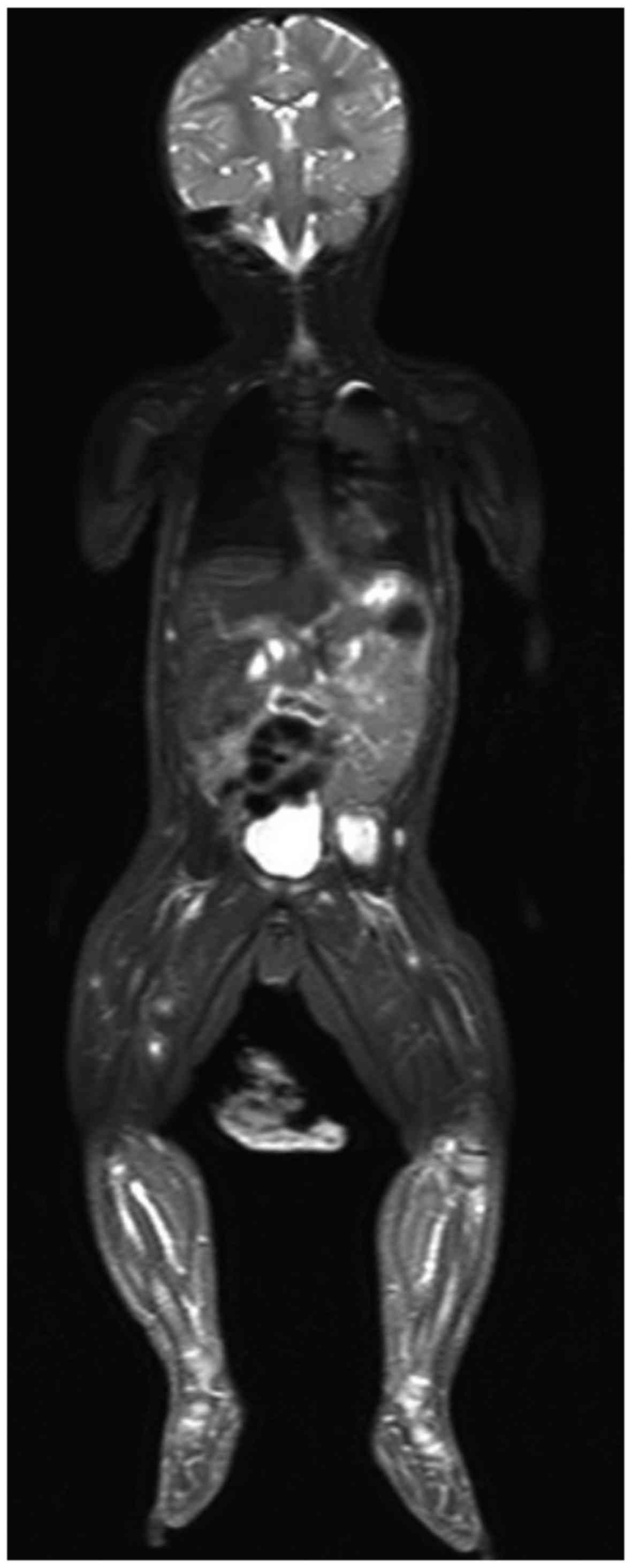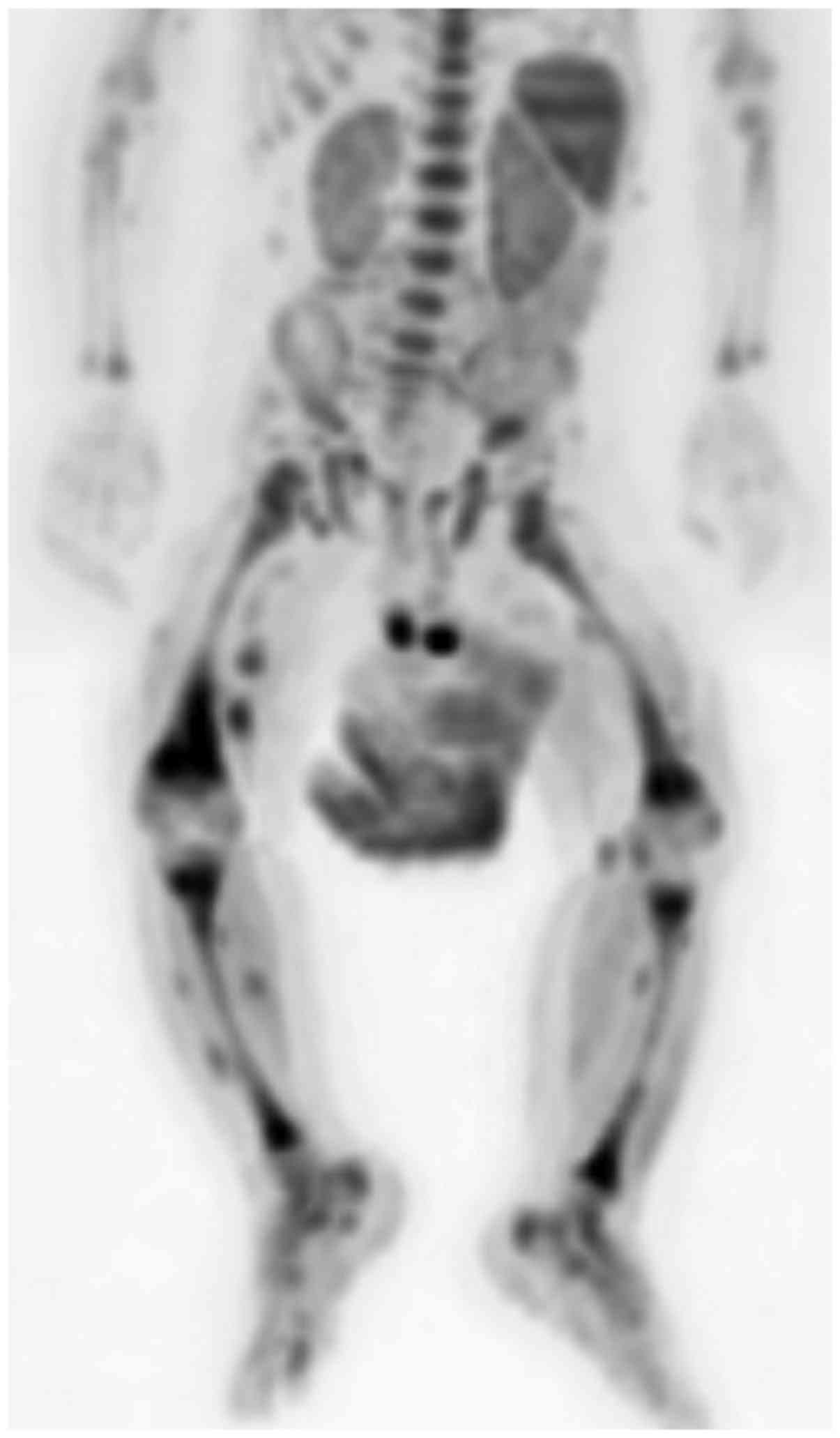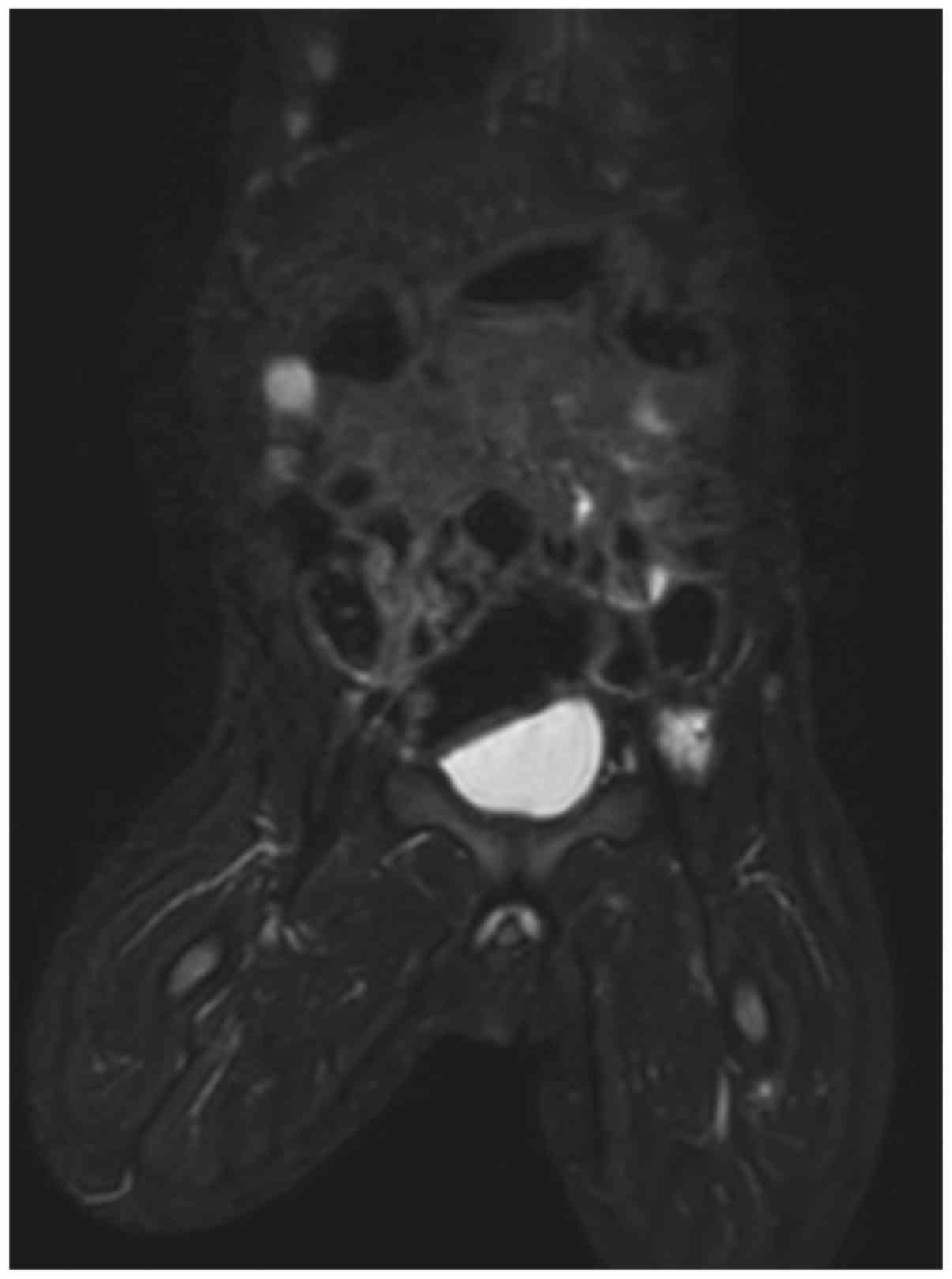Whole-body magnetic resonance imaging in the diagnosis and follow-up of multicentric infantile myofibromatosis: A case report
- Authors:
- Sergio Salerno
- Maria Chiara Terranova
- Mario Rossello
- Maria Piccione
- Ottavio Ziino
- Giuseppe Lo Re
View Affiliations
Affiliations: Department of Radiology, University Hospital Paolo Giaccone, I-90127 Palermo, Italy, Department of Radiology, ‘Civico‑Di Cristina-Benfratelli’Municipal Hospital, I-90127 Palermo, Italy, Department of Pediatrics, Villa Sofia-Cervello Hospital, I-90146 Palermo, Italy, Department of Pediatric Oncology, ‘Civico‑Di Cristina-Benfratelli’ Municipal Hospital, I-90127 Palermo, Italy
- Published online on: February 17, 2017 https://doi.org/10.3892/mco.2017.1171
-
Pages:
579-582
Metrics: Total
Views: 0 (Spandidos Publications: | PMC Statistics: )
Metrics: Total PDF Downloads: 0 (Spandidos Publications: | PMC Statistics: )
This article is mentioned in:
Abstract
Myofibromatosis is an uncommon disorder of infancy, characterized by proliferation of myofibroblasts in solitary or multiple nodules. The clinical characteristics depend on the involved sites: Myofibromatosis may develop as a musculoskeletal form, with non-painful swellings and eventual mass effect symptoms, or as a generalized form with visceral involvement and organ failure. Prognosis and therapy vary between the abovementioned patterns. When there is no visceral involvement, the tumors may regress spontaneously; however, the visceral form may represent a lifethreatening condition with poor outcome and it requires aggressive management. Imaging assessment of disease spread is mandatory to determine diagnosis, prognosis and therapy. Due to the young age of the patients, a radiation-free evaluation is recommended. We herein describe a case of musculoskeletal myofibromatosis diagnosed in a 3-month-old male infant, investigated by serial wholebody magnetic resonance imaging (MRI) examination. The histological analysis and MRI characteristics enabled a correct diagnosis and organ involvement assessment with no radiation exposure. Moreover, whole-body MRI sequences provided a detailed evaluation of the disease within a short time frame, reducing the time of sedation, which is required to perform MRI in very young patients. Therefore, whole-body MRI was found to be accurate and safe in the diagnosis and follow-up of multicentric infantile myofibromatosis.
View References
|
1
|
Chung EB and Enzinger FM: Infantile
myofibromatosis. Cancer. 48:1807–1818. 1981. View Article : Google Scholar : PubMed/NCBI
|
|
2
|
Gopal M, Chahal G, Al-Rifai Z, Eradi B,
Ninan G and Nour S: Infantile myofibromatosis. Pediatr Surg Int.
24:287–291. 2008. View Article : Google Scholar : PubMed/NCBI
|
|
3
|
Koujok K, Ruiz RE and Hernandez RJ:
Myofibromatosis: Imaging characteristics. Pediatr Radiol.
35:374–380. 2005. View Article : Google Scholar : PubMed/NCBI
|
|
4
|
Larralde M, Hoffner MV, Boggio P, Abad ME,
Luna PC and Correa N: Infantile myofibromatosis: Report of nine
patients. Pediatr Dermatol. 27:29–33. 2010. View Article : Google Scholar : PubMed/NCBI
|
|
5
|
Murphey MD, Ruble CM, Tyszko SM,
Zbojniewicz AM, Potter BK and Miettinen M: From the archives of the
AFIP musculoskeletal fibromatoses: radiologic-pathologic
correlation. Radiographics. 29:2143–2173. 2009. View Article : Google Scholar : PubMed/NCBI
|
|
6
|
Counsell SJ, Devile C, Mercuri E, Allsop
JM, Birch R and Muntoni F: Magnetic resonance imaging assessment of
infantile myofibromatosis. Clin Radiol. 57:67–70. 2002. View Article : Google Scholar : PubMed/NCBI
|
|
7
|
Menéndez-Arzac R, Valdez-Méndez D, Landa
R, Guzmán S, Cárdenas E and Cano AM: Solitary infantile
gastrointestinal myofibroma: Case report. J Pediatr Surg.
40:1361–1363. 2005. View Article : Google Scholar : PubMed/NCBI
|
|
8
|
Mentzel T, Calonje E, Nascimento AG and
Fletcher CD: Infantile hemangiopericytoma versus infantile
myofibromatosis. Study of a series suggesting a continuous spectrum
of infantile myofibroblastic lesions. Am J Surg Pathol. 18:922–930.
1994. View Article : Google Scholar : PubMed/NCBI
|
|
9
|
Chavhan GB, Babyn PS and Whole-Body MR:
Imaging in Children: Principles, Technique, Current
ApplicationsCurrentApplications, and Future Directions.
Radiographics. 31:1758–1774. 2011. View Article : Google Scholar
|
|
10
|
Teixeira SR, Junior J Elias,
Nogueira-Barbosa MH, Guimarães MD, Marchiori E and Santos MK:
Whole-body magnetic resonance imaging in children: State of the
art. Radiol Bras. 48:111–120. 2015. View Article : Google Scholar : PubMed/NCBI
|












